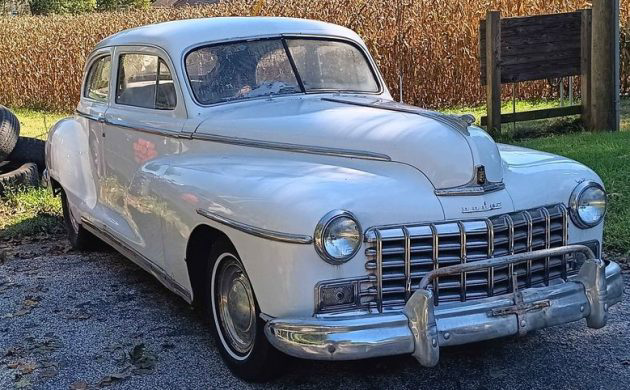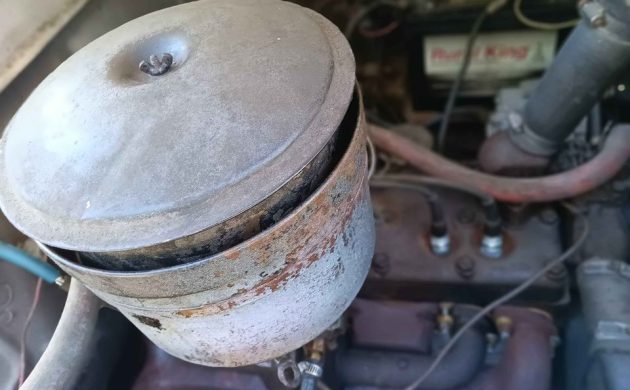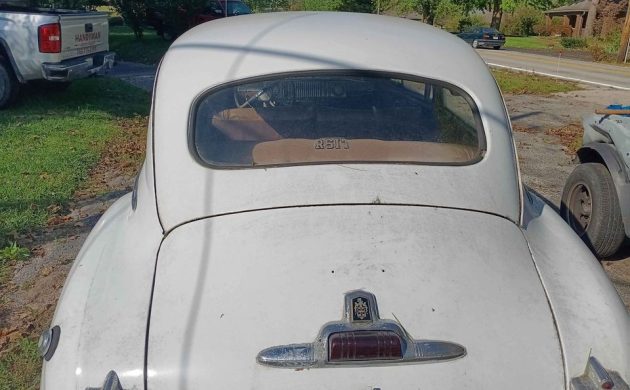Reasonably Priced: 1948 Dodge Custom
What we have here is a fairly innocuous 1948 Dodge Custom two-door sedan, one of 81K assembled that year. I can remember a time, years ago, when you would encounter Dodges from this era (’46-’48) with surprising regularity but I can honestly say that I haven’t spied one like this in many years. Ted discovered the listing for this Martinsville, Indiana resident (thanks Ted!) and it appears to be a very original specimen so let’s give it the once over.
Dodge did surprisingly well in the 1948 production race, putting up a fourth-place finish with 243K units going to brand-new buyers. Trim levels were two, Custom and Deluxe while body styles include two-door sedans, coupes, and convertibles as well as four-door sedans and town sedans. The seller of this example states, “Everything is original on it all the way down to the hubcaps.” – it looks it. The finish is still pretty fair as is the luster of the stainless trim and chrome-plated bumpers. The body seems pretty straight so prior crash damage shouldn’t be a problem. Other than a cracked passenger-side windshield pane, the exterior really needs no immediate attention.
Dodge power in ’48 meant a 102 gross HP, 230 CI, flathead, in-line, six-cylinder engine, and in this case, it’s attached to a Fluid-Drive, semi-automatic transmission. The seller adds, “It has a right front wheel cylinder that leaks really bad it may stop you one or two times on a full master cylinder. This cannot be driven home due to the brakes.” The mileage recording is stated as 1,111 miles so assume that the odometer has been once around, at least.
The interior is about what one would expect for a car of this age and condition. The chrome work on the center dash is just spectacular IMHO while the vinyl upholstery is tired – no surprise there. The headliner appears to be missing and the images of the floor covering are not that clear – it looks like there’s a loose-cut carpet over the rubber mat. As it currently sits, the interior is useable but it’s the kind of thing that will ultimately require a redo.
So, once again, it’s the age-old question for a car of this vintage, who is the designated market? We’ve discussed this matter, at length, in the past and have collectively agreed that there is a shrinking, and limited market for cars of this era. You’ll find this Dodge sedan here on Facebook Marketplace where it’s available for $3,500 OBO. At that price, there’s a lot here to work with. A stock restore probably isn’t in the cards but a mechanical performance upgrade, while maintaining a stock exterior vibe, is one way to go, wouldn’t you agree?
Auctions Ending Soon
 2006 Ford Mustang Saleen S281 SCBid Now1 days$15,000
2006 Ford Mustang Saleen S281 SCBid Now1 days$15,000
 2002 Subaru Impreza WRXBid Now4 days$100
2002 Subaru Impreza WRXBid Now4 days$100
 1975 Chevrolet Corvette ConvertibleBid Now4 days$1,000
1975 Chevrolet Corvette ConvertibleBid Now4 days$1,000
 1964 Ford F-100 Camper CustomBid Now4 days$500
1964 Ford F-100 Camper CustomBid Now4 days$500
 2006 Jeep Wrangler SportBid Now6 days$1,000
2006 Jeep Wrangler SportBid Now6 days$1,000






Comments
It’s incredibly important to note, for this here crowd, in the 50s these became the standard issue $50 beater. For many their 1st car even before we had our license. We learned all about cars with cars like this. 2nd, it has a snowballs chance in Hades of remaining like this. We all know, as the author mentioned, the appeal of a car like this as is, is dwindling fast. Look at images of any ’48 Dodge today, and most are resto-mods. It really is okay, the lines coupled with modern components makes a dandy hod rod. Like this? Not so much. One thing is clear, this stuff just keeps coming out of the woodwork, literally, and probably will for years to come. Whether there will be a market for it, or not, time will tell.
Do what is necessary to make the Dodge drivable & go!
I would keep it stock. I don’t think it would take a lot of effort to get it back on the road. The interior can be worked on as time and resources permit. I would actually make an offer if it was closer. GLWTS.
I was 8 years old in 1955 and that’s when my dad decided I should learn how to drive a car with a clutch and 3 speed column shift. It was a green 48 Dodge 4 door sedan with fluid drive. The car lasted another 3 years before it was retired to the back of the farm with other cars of same fate. I do believe it’s fairly easy to put a slant 6 in these cars or even a V8. That’s what I’d do. The brakes on these cars are a simple system but usually require new or rebuilt hydraulic parts. Master cylinders can be drilled and sleeved. They have no self adjusters so require adjustment regularly. It’s a nice looking 2 door and I hope it finds a good home.
God Bless America
These, and ’48 Plymouths, seemed to hang around for but EVER. And in the 1970s and ’80s, when you no longer saw so many on the roads, you spotted them lurking in garages, fields, and back yards. I know of two ’48 Dodges in this area, still driven occasionally by owners in their nineties. I think this one deserves a mechanically worthy fix-up to put it back on the road — then simply drive it the way it is, decaying interior and all. But CHANGE that rubber gasket around the rear window: they tended to leak.
These are tough old cars. I know as I hit one broadside when the driver pulled in front of my ’54 Chevy. Chevy was totaled and the driver drove his home.
Looks as though there’s almost no rust on the body – maybe the underside is the same – would make a cheap start to a project – make it a V8 auto for not to much $.
A friend of mine had a 4 door ’48 Dodge.
If you put that transmission in 3rd and dumped the clutch, it took an hourglass to measure the 0 to 60 MPH time!
It was slower off the line than my ’52 Buick Super Dynaflow!!!
With all due respect: PERFORMANCE is NOT the reason to own a 1948 automobile! They DO what they DO, and they do it very well. But beating every other vehicle whilst streaking like lightning down the Interstate is not what they were designed to accomplish. Get that original powerplant and transmission operating properly, and then DRIVE it. If that leaves you “lacking”, then buy a 1960s “muscle” car instead. I drove a 1946 Ford Super Deluxe V-8 for many years; and because it had a Columbia Overdrive, I could go anywhere with it, and not delay traffic, and I did. Couldn’t “burn rubber”; though, last time I checked, that just harms tyres. A car, for me, is practical TRANSPORTATION — not for show-off. As long as I can go where I wanna go, without a break-down, then I’m good. And I definitely could do that in a factory-equipped 1948 Dodge.
I had a 48 Dodge Business Coupe in ’73. I was not a fan of the Fluid Drive, although I took advantage of the clutch-less driving. The parking brake wouldn’t hold the car in a driveway with a slight slope. Eventually, something in the wiring went bad and the headlights would just switch off for 20 – 30 seconds. So rather than scheduling it for repair, I pulled the engine to put a slant 6 in. I couldn’t get the slant to fit and my good running flat head was already sold, so a friend was building a Humpback Dodge street rod, gave me his engine and transmission. That was the first engine I rebuilt. The whole project stalled and a decade later I I traded it to the same friend for a 65 Fiat 1500 Cabriolet when his interest in that waned.
To echo Harrison Reed’s comment, I found the ride in my ’48 to be very good. I noted it to take gravel roads extremely comfortably. Dirt roads were everywhere then. As long as they were well cared for and kept reasonably smooth, I would say the cars of that era were well built for what the driving conditions were in most of the post-war USA.
We needed the ‘Speed Merchants’ in the sixties to create the bigger desire for speed and the factory built hot rods
Thank you, John D.! Highways drastically improved after the War, and SOME increased horsepower was in order. But, for regular driving, the obsession with “muscle” performance was unnecessary. It was wasteful on gas-mileage, and it led to some using streets as race-tracks, risking life and limb for themselves and others: I mean, why own a car capable of racing speeds, only to assiduously obey speed-limits? But the speed limits are there for our SAFETY. And one doesn’t need “muscle” to drive safely. A 1948 Dodge might “stress” a bit driving all day in the Interstate — but that was not an issue in 1948. You don’t take something 76 years old, and work it as though it were new — you respect it for what it is, and you keep in mind that it’s components are not as hearty as they were when it was young (just as we do with ourselves!)
I was driving about seven miles from home, when a 1946-’48 maroon Dodge came toward me on the other side of the road. It warmed my heart, to see it. The car was a bit dull-finished, but appeared to be original. The driver looked to be about 95-years-old. I would have loved to have met him and heard the “back-story” on this one!